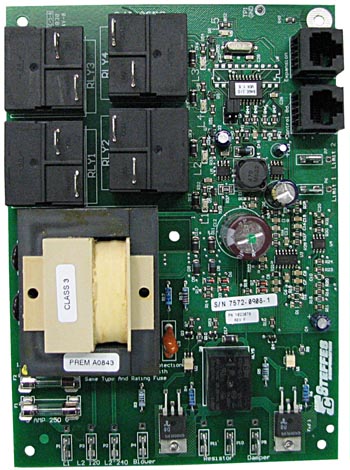Part 6 Description - 2100 Series
Base I/O Relay Board
The base I/O relay board provides power to the processor control board and the optional time clock module. The base I/O relay board receives commands from the processor control board to power outputs including the heating elements, blower, and damper. The board is isolated from the back of the unit by an insulating paper. Line voltage power comes into the heater at the base I/O relay board. The board is configured with a multi tap input; therefore, L1 is the common terminal, L2 120 is for 120 volt systems, and L2 240 is for 240 volt systems.
NOTE: DO NOT apply voltage between L2 120 and L2 240!
The base I/O relay board also acts as the power line carrier (PLC) receiving device for the heater. PLC signal is read by the base I/O relay board and digital information is sent to the processor control board. PLC problems at the heater level would be caused by the base I/O relay board.
There are two (5 x 20 mm, 250VAC) fuses on the base I/O relay board. The 1/4 amp (250mA) slow-blow fuse (order item #1024036) provides power to all of the circuit boards in the system. Input voltage to the system can be verified by reading voltage AC from L1 to L2 120 or L2 240. Control voltage on the board can be found by reading voltage DC between the Limit 2 (P7) and chassis (ground). This voltage should be 10-11 volts DC. If this fuse is open, the system's display will not illuminate. This input is protected with MOV circuit protection; therefore, a high voltage surge, incorrect input voltage wiring, or a base I/O relay board problem can cause the fuse to open. For troubleshooting information, refer to the Base I/O Fuse Open flowchart.
The 5 amp quick-blow fuse (order item #1024037) on the base I/O relay board protects the variable voltage (triac) outputs for blower and damper control. These outputs pass voltage from the L1 terminal to the blower and damper output terminals. If this fuse is open, the most probable causes would include a shorted blower, a short in the blower wiring, or a shorted damper actuator or wiring. Check the blower and damper actuator for electrical short line to line or line to ground, if open, replace the fuse and perform the check-out procedure. High voltage events have been suspected of opening this fuse and other blower or damper control issues may result.
To test functionality of the base I/O relay board, in a 2100 series only, power down the system at the breaker. Place the J1 and J2 jumpers in the "on" position (both pins covered with connector). Energize the system and the board will begin a self-test. When in this mode, the element relays will close and open, the blower will ramp up in speed then back down, and power to the damper will be turned on and off. If the board fails this test, it must be replaced.
NOTE: using this self-test feature for long periods of time, or in other models (such as 4100 or 5100), could result in failure of the blower motor or tripping the safety limits. Unit must not be left unattended in this mode.
